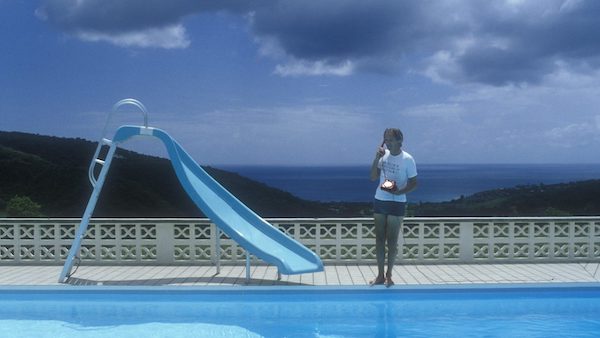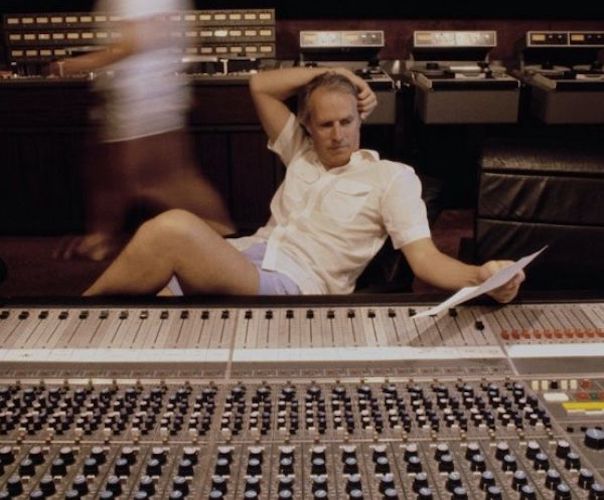Film Review: “Under the Volcano” — Island Music
By Ed Symkus
Sir George Martin’s AIR Studios in Montserrat gave birth to some great ’80s music, then succumbed to the elements.
Under the Volcano, directed by Gracie Otto, premieres On Demand and digitally on Xfinity, Google Play, iTunes, Prime Video, and other platforms on August 17.

George Martin at AIR Studios Montserrat in Under the Volcano. Photo: Martyn Goddard/Universal Pictures Content Group.
Australian filmmaker Gracie Otto’s feature documentary, having nothing to do with the Malcolm Lowry novel of the same title, is part travelogue, part historical document, part disaster tale, and part ode to the post-Beatles accomplishments of record producer Sir George Martin, who died in 2016 at the age of 90.
But the film’s main subject, set on the once-serene, picturesque, pear-shaped West Indies Island of Montserrat, is AIR Studios, the state-of-the-art recording facility that was the brainchild of Martin. It was an idea he developed soon after the breakup of the Beatles ended his producing tenure with them.
The story is told via archival footage and photographs of studio sessions, new and old interviews with musicians, technicians, and people who were close to Martin, and some gorgeous shots that could have come from the Montserrat Department of Tourism.
Some context: AIR (Associated Independent Recording) Studios came into being in London in 1970, a combined effort of producers George Martin, Ron Richards, John Burgess, and Peter Sullivan. It was a hit factory, and a photo montage offers a glimpse of some of the artists who made music there. Among them: America, Wings, Pink Floyd. Stevie Wonder, Brian Eno, Olivia Newton-John, Jeff Beck, Kate Bush, Fleetwood Mac, Queen, and Cat Stevens.
Martin certainly chose the right career. In an undated clip, John Lennon, talking about Martin and his methods, says, “He had a very great musical knowledge and background, so he could translate for us and suggest a lot of things.” Then, in an amusingly posh imitation of Martin, he adds, “Look, chaps, I thought of this this afternoon.”
At one point, Martin is on camera, explaining, “You can put a very soft flute against a huge brass chord and still make it sound loud.”
But the producer had had enough of chaotic London and, according to a current interview with his son Giles, who has since stepped into his dad’s producing shoes, was tired of “the rigid structure of EMI Studios, and he wanted to build a place that was more artist-friendly.” His widow, Lady Judy Martin, added, “George was looking for something which wasn’t in the middle of London. His plan was there would be a lack of hangers-on. Just the recording artists and their families.”
Research led him to idyllic Montserrat, an island he fell in love with, and it became the site of the sister studio to the London spot. It was a place that Dire Straits frontman Mark Knopfler remembers as “far more innocent and quieter than other islands there.” Sting claims, “There’s a mystique about the island.” Jimmy Buffett, one of the first artists to record there, upon its opening in 1979, says it had “a lovely working environment, so different from the less-relaxed Nashville.”
Another photo montage, this one of who recorded in Montserrat, includes America, Nazareth, Luther Vandross, Annie Lennox, Dave Stewart, Sheena Easton, Ultravox, and Roger Daltrey.
Among the highlights of the film, and some of Otto’s best finds, are an older interview with Paul McCartney, talking about the creation of “Ebony and Ivory” with Stevie Wonder, along with footage of that session, and all three members of The Police — separately, in contemporary interviews — recalling when and how they recorded “Ghost in the Machine” and “Synchronicity” there (both of which were produced by Hugh Padgham, often under the watch of Martin).

George Martin at work in AIR Studios Montserrat in Under the Volcano. Photo: Universal Pictures Content Group.
But in the latter parts of the film, the subject matter shifts away from the studio and more toward the musicians, especially into the problematic side of things. AIR Studios might have been a nice place to escape to, where fresh ideas could come to life, but for some of them — Lou Reed, Black Sabbath, and The Police are mentioned — isolation sometimes got in the way. And since it was a single studio situation, with only one band at a time in residence, there was also the dilemma of bandmates getting on each other’s nerves. Too much screen time is given to Sting, Andy Summers, and Stewart Copeland (The Police) grousing about just that.
There’s also the issue of the title, which is more than a bit deceptive. Yes, the long-dormant Soufrière Hills Volcano is on Montserrat. Yes, it became active in 1995, and caused massive destruction in 1997. But, as explained in the film, AIR Studios was destroyed in 1989 by Hurricane Hugo, shortly after the Rolling Stones recorded Steel Wheels there. It was all those years later that the volcano rendered half of the island uninhabitable.
Almost as an afterthought, mention is made that by the time of the hurricane, the facility — once a crown of studios — was on the way to becoming outmoded, due to new developments in recording technologies. Though some of the film’s focus is lost near the end, it stands as a fascinating look at a time when some amazing music was created in a special place. In the words of Giles Martin, “Montserrat was a dream that my father fulfilled.”
Ed Symkus has been reviewing films and writing about the arts since 1975. A Boston native and Emerson College graduate, he co-wrote the book Wrestle Radio, USA: Grapplers Speak, went to Woodstock, collects novels by Harry Crews, Sax Rohmer, and John Wyndham, and has visited the Outer Hebrides, the Lofoten Islands, Anglesey, Mykonos, the Azores, Catalina, Kangaroo Island, and the Isle of Capri with his wife Lisa.
His favorite movie is And Now My Love. His least favorite is Liquid Sky, which he is convinced gave him the flu. He can be seen for five seconds in The Witches of Eastwick, staring right at the camera, just like the assistant director told him not to do.

